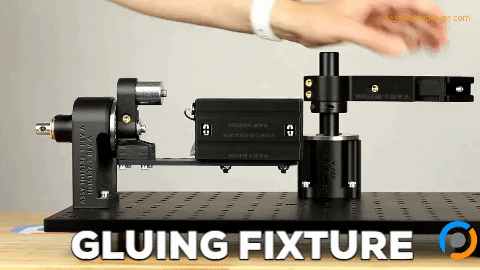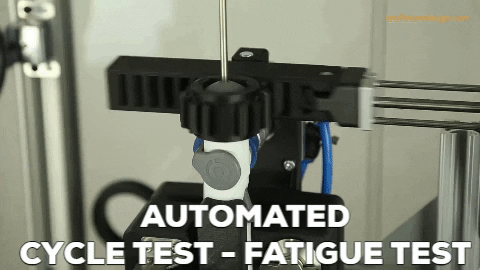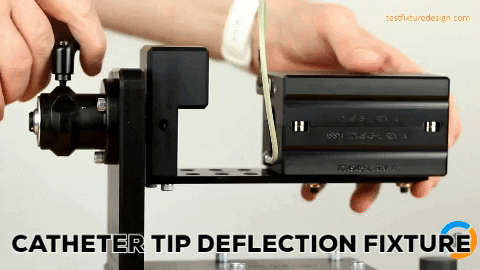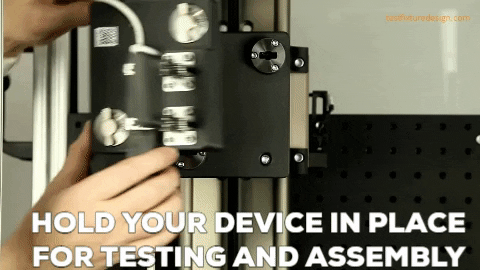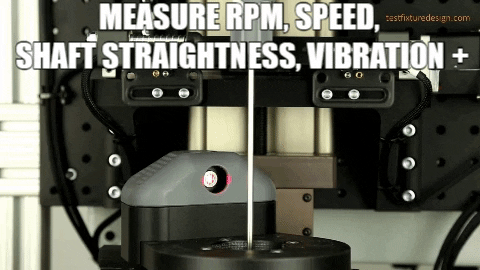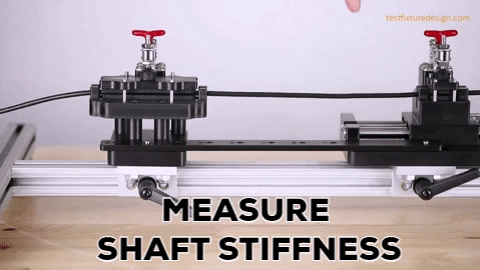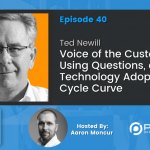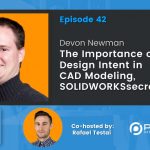The Hacksmith James Hobson
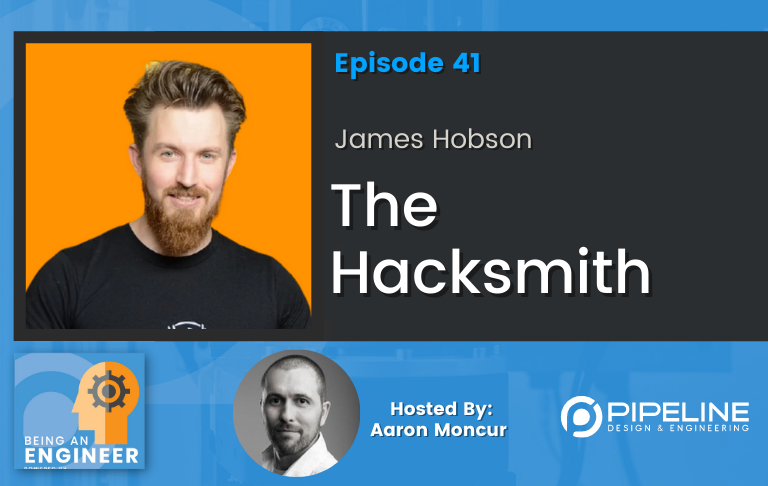
James Hobson | The Hacksmith
Many of you know James Hobson from his wildly popular YouTube channel Hacksmith Industries. James has a degree in mechanical systems engineering and runs Hacksmith Industries, a company he founded that takes fictional ideas from comics, movies and video games and makes real working prototypes as a way to inspire youth around the world into STEAM fields.
A few of the amazing projects he and his team have completed over the years include a working Ironman helmet with heads up display, a half scale Tesla Cybertruck, a functioning light saber, Wolverine claws, Thor’s hammer, an electromagnetic arm bracer for a Captain America shield, and a Batman grappling hook gun. Therefore, I encourage our listeners to check out his YouTube channel Hacksmith Industries. Indeed, great content!
EXPAND TO VIEW EPISODE TRANSCRIPTION
SUMMARY KEYWORDS
projects, engineering, parts, cool, engineer, videos, loader, exoskeleton, bit, design, learn, industries, year, backflips, gave, world, hack, machine, technology, youtube channel
SPEAKERS
Aaron Moncur, Presenter, James Hobson
Presenter 00:00
The being an engineer podcast is a repository for industry knowledge and a tool through which engineers learn about and connect with relevant companies, technologies, people, resources and opportunities. Enjoy the show.
James Hobson 00:15
There might be a niche for this, like people like seeing cool engineering projects, and mixing in that kind of like superhero motif is also very effective at bringing in a whole new audience of the kids and adults out there who love superhero movies.
Aaron Moncur 00:44
Hello, and welcome to another episode of The being an engineer podcast. We have a special treat for you today. Our guest is James Hobson, aka the hack Smith. Many of you will know James from his wildly popular YouTube channel hack Smith industries. James has a degree in mechanical systems engineering and runs hack Smith Industries, a company he founded that takes fictional ideas from comics, movies and video games and makes real working prototypes. of few of the amazing projects he and his team have completed over the years include a working Iron Man helmet with heads up display, a half scale, Tesla cybertruck, a functioning lightsaber, Wolverine claws, Thor’s hammer, and electromagnetic arm bracer for a Captain America shield, and a Batman grappling hook gun. This is not an exhaustive list. And there are plenty of other projects, I encourage our listeners to check out on his YouTube channel hack Smith industries. James, thank you so much for joining us, and welcome to the being an engineer podcast. Glad to be here, Aaron. Well, what made you decide to become an engineer?
James Hobson 01:54
So back in high school, I did a shop class that was called integrated tech. And at the time, I didn’t know what engineering was. But I really enjoyed tech class. I liked working with my hands working hand tools, power tools, you name it. And throughout that class, I realized, Oh, this is this is what engineering is. And then that’s kind of what set me on the career trajectory to become an engineer and continue working with my hands 15 years later.
Aaron Moncur 02:22
Very cool. Now I went back way into the archives of your videos, and I looked at some of the very first ones. And I just I love that these are still there because they have nothing to do with what you’re doing right now. As far as I can tell. They’re mostly videos of you and your friends in high school doing backflips and front flips and like launching off of cars and walls and parkour and stuff like that. Which it just seems so genuine to me that they’re still there. So a I love that they’re there. The Can you tell me? How did you get into to that sort of thing? The the gymnastics, the acrobatics, the backflips, how did that all happen?
James Hobson 03:00
I was always pretty athletic. As a kid I was enrolled in gymnastics when I was young. And then that was when parkour took the internet by storm back in like the early 2000s. And you had all the sampler videos of people doing death defying stunts, jumping off buildings and running around. And I obviously thought that was super cool. So I started doing similar stuff like that tried to make my own videos. It was never quite quite as cool as the the pro videos that I had seen. But it was part of the reason that I actually got into filming videos was to make these kind of like tricking samplers and things where it’s just like, let’s see what we can do. Cool.
Aaron Moncur 03:39
So that it was important, inspired by the comics that you were reading and movies that you were watching.
James Hobson 03:44
A little bit. Yeah, I’ve always been. I’ve always loved superheroes. And I grew up watching Smallville, a story of Clark Kent before he picked up a Superman. And I guess I’ve always had that kind of like superhero motif where it’s just like, man, it’s cool to be like, be able to do, like, do things that not many people can do. Like, I feel like that’s held true for like most of my life. And just like the crazy shenanigans I get up to like normal phrases for me is like, Oh, I was flying a jet pack last weekend. And it’s just like, it says that video.
Aaron Moncur 04:20
Well, I watched another of your older videos. This one was from when you were in college, and it was this this automated machine you put together which I picked up on really quickly because that’s what we do. At my company. We build automated equipment. And this one was this machine where it took like a brass ring and it pressed it into a washer. And I thought to myself what a great project and it was really impressive. In part because it was a group of students who had done this and it was it was an impressive machine. Were you exposed to a lot of like design and engineering and technology. Growing up throughout your upbringing or or was it really kind of when he got into college that you started developing those skills?
James Hobson 05:06
Definitely started in high school with the tech class, we were in a robotics club me my my business partner and Hillier. And we definitely took on more projects and learned more about the different tools we can use, like the tech class had a CNC machine that we learned how to use and stuff like that. But as far as like the manufacturing automation technology, that was all thanks to our program at Conestoga. College. So the program’s name when I started was actually integrated advanced manufacturing technologies. And something something it was it was a mouthful, but by the time I graduated, they changed the name to mechanical systems engineering, which has a nice ring to it, in my opinion,
Aaron Moncur 05:47
but shield, right.
James Hobson 05:50
But yeah, that was our second year capstone project. So it was a year long project. And it was myself, my business partner, and one other classmate who made that machine. And the reason we actually went to console college was because of had more of that hands on application than most typical engineering programs do. Whereas usually, in general, I can’t speak for every engineering school out there, but usually it’s in third and fourth year where you actually get to like, get your hands dirty. Whereas in our program, we had machine shop classes in year one, we were building stuff like every year was an actual physical project, except the last year.
Aaron Moncur 06:27
Oh, interesting. That’s awesome that you guys had so much hands on opportunity. I remember. In my education at college, I think like you said, it was the last year right, we had a capstone project. And that was probably the funnest year from an engineering standpoint. The rest of it was mostly theory, right? Textbooks and doing homework problems and boring stuff like that. Well, how did you how did you make this transition from what what seems like just a bunch of high school friends kind of having fun making videos, to this incredible business hack Smith industries, how did that transition occur?
James Hobson 07:06
I mean, it’s a pretty long story, but I’ll try and try and summarize it for you. I enjoyed making videos just as a way to show off something that I had done. I also wrote a blog back in the day, and basically was just my way of documenting projects. Because I found that was the easiest way to share with friends who aren’t physically nearby. So I started making videos. And I basically make videos of whatever I was doing, whether it was parkour gymnastics, or making engineering projects, converting a 1993, Honda Del Sol to electric. And what happened was, I kept making those videos, mostly just for personal reasons to share with other people. But then my last year of college, YouTube actually opened up the partner program to basically anyone who wants to apply. And I thought, man, it would be really cool to make money off the internet for something I’m already doing. So that’s kind of what gave me the inspiration to continue doing it as I graduated, actually went into the workforce. And I gotta admit, I don’t know how I kept up with it, because I was doing one to two videos a week. And while working full time, and for about two years, I barely had any traction whatsoever. So it really was a labor of love. I saw the possibility of the channel like growing and becoming something. But honestly, for those first two or three years, nothing, nothing really happened until we had one kind of like breakout project. And that was the Elysium exoskeleton build. So one of my coworkers actually gave me some pneumatic cylinders, which at the time were the most expensive part of the project, but I couldn’t afford it. So as soon as I had those pieces, I’m like, Okay, now I can build something around these. And I was able to make a pretty janky upper body exoskeleton that only had one range of motion, it could curl, but it could curl about 180 pounds in the test video. And that video went somewhat viral, got lots of views, and it made me realize, hey, there might be there might be a niche for this, like people like seeing cool engineering projects. And mixing in that kind of like superhero motif is also very effective at bringing in a whole new audience of the kids and adults out there who love superhero movies. So the nice thing is I kind of found this nice little crossroads where I can show engineering, not just to people who like engineering, I can show it to people who also just like mainstream superhero movies and media, and I often say like, like the what Marvel’s done with the MCU has really helped helps give me a guiding line to to guide my YouTube channel because if Ironman wasn’t so popular, I wouldn’t be able to do these engineering things and make them so cool I feel because as cool as it is being an engineer, innovator inventor on the internet, and you can find some success with that. Being able to tie it to pop culture that has even more exposure, I think is kind of the secret sauce that really helped propel our channel into being pretty well, the biggest engineering channel on the internet, which is kind of cool. Yeah, that’s
Aaron Moncur 10:16
a key insight there. Speaking of the biggest engineering channel on the internet, do you remember that exoskeleton video? I know it’s a lot higher now than it probably was back then. But approximately, how many views did you get? When you said to yourself, oh, yeah, okay, this, this could be a thing that has a future,
James Hobson 10:37
I think it was only a couple 100,000, it might have hit half a million or so. Okay, and the channel did grow quite a bit. I think I hit about 70,000 subscribers by the end of that year. And it was the next year that I decided to quit my engineering job and pursue YouTube full time. And at that point, I only had 70,000 subscribers, which wasn’t enough to make money off of the channel, really. So I had I think about six months of savings. And I knew like I had to make it in six months, or get another engineering job and give up on the YouTube dream. So yeah, luckily, that didn’t happen.
Aaron Moncur 11:13
So it grew pretty quickly, then, I mean, if you had a six month runway, and before that runway edit, you had enough growth on the YouTube channel.
James Hobson 11:21
Yeah, it was pretty lucky. I quit my job on November 11 2015. We cracked 100,000 subscribers, I think in March 2016. And that summer was when we had our, our real viral breakout success. And that was the captain america electromagnet shield. And those two videos ended up getting millions of views within a month, and a channel went from 100,000 subscribers to half a million subscribers. Wow, just over 30 days, what has suddenly been? Yeah, it was, it was quite a wild ride, because quite literally, we got from being a small YouTube channel to being a decently sized YouTube channel. And as soon as we hit that size, sponsorship offers start coming in. So being able to charge for additional advertising within our videos, which is how this business is able to do what it does. Yeah, so. And then since then, I think for the following four years, we pretty well doubled in size, year over year for four years straight. So views, subscribers, employees revenue, you name it, it was pretty much just a rocket ship straight up. It’s slowed down a little bit. But we’ve also done massive expansion around a 13,000 square foot facility. And that’s just kind of the nature of the platform. There’s not too many channels that can sustain exponential growth forever. Yeah, of course. Right.
Aaron Moncur 12:43
Congratulations. That’s amazing success. I imagine that people who watch your videos, they probably don’t have a full appreciation for just how much time and and probably money as well. But but really the time and effort it takes to put these together, especially when we’re seeing Tony Stark and Jarvis put together a full Ironman suit in like two days, right? Like, that’s not reality.
James Hobson 13:09
I both love and hate the movie. portray invention and just physics. Yeah. It’s just like, Oh, why don’t you do this? It’s like, well, because that’s not possible. Yeah.
Aaron Moncur 13:21
Yeah. Electrons don’t move that way. Yeah. How? I know that they probably vary quite a bit. But on average, roughly speaking, how long does it take to put together one of these projects and what all goes into it?
James Hobson 13:37
So it really depends on the project. Obviously, we have very long form projects, and rather short ones, there are some projects that we’ve whipped out in a day. And then there’s ones that take months, and ones that take years. So our power loader project is finally coming to its end in the next month or two. And that’s been going on for two and a half years now. The cybertruck, we managed to whip that out in I think just under eight weeks start to finish, which was pretty fast for what it was. I was actually much more ambitious. I thought we could do it in one month. I was mistaken. But
Aaron Moncur 14:13
I remember hearing you talk about how long it took to put together that half skill Tesla cybertruck And I think to myself, Okay, what are the projects that we’ve done within an eight week period and there aren’t that many, most of our projects are, you know, three or five or six or a year long. And when I think of the ones that are eight weeks, they’re like, orders of magnitude simpler than Tesla cybertruck. How did you get that done so fast? Ah superpowers
James Hobson 14:47
superpowers. It’s like it’s just kind of it’s what we do like we are a r&d Skunk Works at heart. And the nice thing with what we do versus what say you’re kind company does is our products really are prototypes. And I like to say prototyping is the first 10% of the project. It’s also the most fun part of the project. Yeah, yeah. But it’s definitely not ready to take the market after you’ve done 10% of the work. So we get to kind of skip out on a bunch of the boring engineering, like, maker, documentation, documentation, reliability, customer service, I’m so glad we don’t have customers, at least customers for the engineering project, we have customers and that we have brands who, right want views on our YouTube videos, but that’s easy to deal with. But yeah, it just it really simplifies the engineering process, makes it a heck of a lot more fun. And allows you to accelerate that timeline quite a bit. Because Oh, the other thing is we, we do spend a lot of money on these projects. So it’s like, oh, would that make it with this $1,000 component, make it quicker? Okay, let’s find the $1,000 component. whereas traditionally, most engineering projects have a very fixed budget. And that’s part of the reason why you take more time making sure your designs perfect. Whereas we’re a bit more of a running gun. Let’s get it done.
Aaron Moncur 16:14
Well, I think you’ve found the perfect business model, at least as far as engineers are concerned, right? They just get to jump in and do the fun stuff right away and not worry about the rest.
James Hobson 16:23
Yeah, it’s definitely a dream job for pretty much everyone who works here. And a lot of the fans who wish they could work here.
Aaron Moncur 16:30
Oh, for sure. Yeah. Well, you you had a couple of quote unquote, real jobs before you started full time at it, hack Smith industries. Did those Do you feel like those jobs prepared you to be successful as the hack Smith?
James Hobson 16:45
I mean, everything, as you know, with engineering, like every experience helps you in some way. Yeah, a lot of a lot of jobs at engineering companies tend to be fairly specific, though, towards that industry that you’re in. So for example, my first job was working at a company called Athena automation. And I was a mechanical designer, the company made injection molding machines. That job gave me a lot of skills in SolidWorks, which obviously used today in sheet metal design, because our, our team was the base team. So we we basically made the giant steel weldment that the entire machine gets mounted to and all the subsystems get attached to as part of that we were also responsible for the pneumatic system and the water system inside. So I did actually learn a lot from that job about hydraulics, which we use in the aliens power loader, and pneumatics, which I’ve used a whole bunch as well. And I was actually just looking through my notes, I made some design reference, like cheat sheets for that company. And looking at it now. And like, Oh, this is kind of useful towards like the power level design, basic do’s and don’ts of reading hydraulic hoses, how to measure different fittings for doing like hose runs, manifold design, stuff like that. So I did definitely learn quite a bit about that for like, heavy fabrication, stuff like that. But a lot of the projects don’t really have anything to do with that. My second job was working as a product developer for a company called Christie digital, they were one of the world leaders in digital projection technologies. So most movie theaters use a Christie digital projector. And that one definitely exposed me a lot more to rapid prototyping because I had a very big rapid prototyping shop and I was a very hands on engineer. So I’d be going downstairs, checking out my parents seeing if they work and whatnot, which is also a lot of fun, and definitely, definitely helped. But as far as like YouTube, and even just doing home projects, really it is you’re learning something every project that you do. You’re never going to know everything when you start a project. So it’s really an iterative learning process, developing these skills, developing your engineering skills, and developing the new skills that you might need for this new project that you’re working on. And that’s why I love the internet, because you can find resources on pretty much anything online. And as long as you have a good drive for learning, and you know how to research topics. The world is your oyster, you can you can become an expert in sheetmetal design just by watching SolidWorks tutorials online. Like it’s it’s really awesome. Yeah, it’s
Aaron Moncur 19:31
pretty amazing what you can find online now for engineering, learning educational content. What what are some of the resources that your team uses a lot online in terms of retailers, you know, purchasing hardware, learning new skills, any in particular that come to mind that have been just really that helpful for you and your team?
James Hobson 19:52
I would say mcmaster carr is probably our favorite website.
Aaron Moncur 19:56
So so good to hear you say that. Yeah, true engineer. All right.
James Hobson 19:59
Yeah. up as a Canadian consumer, you can’t sign up for a MasterCard account. But he knows this you can. We have an account. And it’s basically next day delivery on all parts. And if some of your viewers aren’t aware of those strict MasterCard has 3d models of almost every single part they sell, which is fantastic for designing things and engineering stuff, because you can literally download the model, throw it into your assembly. Oh, yeah, that’s gonna work by Yeah. And then it shows up the next day. So mcmaster carr is definitely a very helpful resource. Obviously, it can be a bit expensive sometimes, but our budgets don’t really don’t really care, care about the little things like that. And then, on the electronic side of things, we’ve actually been working with Digi key for, I think, four or five years now. So they’re one of our longest sponsors on board. Basically, they, we order parts from all the time and we get small advertising spend on our videos when we feature Digi key and make your.io and whatnot. Cool. And that’s when those two websites you can get pretty much anything. Yeah,
Aaron Moncur 21:07
those are the big boys. Right? Have you seen the new McMaster cars SolidWorks add in? I have not Oh, man. Yes, yeah, check it out. They have come up with yet another way to make it so easy for us to spend money with big Master. Yeah, it just it scrubs your entire model, it looks for anything that’s mastered part puts it into a list and you just click the button and orders out there. Oh, it’s amazing. Yeah,
James Hobson 21:32
that’s awesome. And then and then, like I said, SolidWorks. We’ve also been working with SolidWorks for three or four years now. So we have full licenses with pretty much all the add ons. Nice. I remember the first time they sponsored us, they gave us three licenses with every add on. And then they sent us an invoice for what the whole package was worth. And that was something like $450,000 with a software, we’re just like, what?
Aaron Moncur 22:00
Well, that’s the superpower right there, right? Being able to get all this stuff for free. So I have probably watched, I don’t know, 50 or 60 of your videos at this point. And they’re all awesome. In some of them. Again, I really appreciate how genuine you are in your videos, because you show some of the behind the scenes stuff, some of the things that maybe don’t go exactly according to plan some of the failures, what had been some of the most epic failures that you guys have encountered in your projects, you know, something catching on fire or blowing a hole in the wall or anything like that, that comes to mind?
James Hobson 22:39
Yeah, there’s definitely been quite a few. We made our own homemade version of Elon Musk’s boring flame thrower, a day after he announced it on Twitter for the first time. And it was fine in that video. But subsequent videos and over the years, we’ve discovered that it leaks propane quite often. And there’s been a few times where it’s a had a bigger fireball from not where it’s supposed to be becoming. There’s another dangerous one where we made a rocket powered battering. And we took it out to a testing field and we tried throwing it and the rocket didn’t go off. Or like oh, shoot what happened. We bring it back to the shop, we take a look. Oh, one of the wires got cut. No problem, solder back together. I’m taking a look at it. And for some reason. I don’t know why I did this. But it has dead man switches so it doesn’t go off in your face. But we also have indicator LEDs. So when you arm it, you can see that the light turns on, it’s ready to go. Well, for whatever reason, I didn’t hold the deadman switch and I flipped it on. I was like, oh, blue light. And suddenly it took off and merrily missed my face and flew away. But that was that wasn’t really an engineering fault. That was just my dumb luck.
Aaron Moncur 24:00
Well, that’s kind of the world of r&d to right stage before all the bugs have been worked out. Yeah.
James Hobson 24:07
Our most recent mishap, again, wasn’t really the fault of engineering. It was more just really ironic. We made a baseball launcher for MLB and X Box this summer. And I broke my hand with a baseball. So baseball did not come from our baseball kid. We were actually just filming some backstory to the video about why baseball pitchers can throw really frickin fast. So we went to a baseball batting cage and we had a pro player throw 90 mile per hour balls at us. And I just so happened to have the bad luck and my reflexes weren’t 150 milliseconds. So the ball was coming and actually hit my hand on the back breaking my fifth metacarpal but on the plus side. I’m well on my way to being real Canadian Wolverine because I’ve got a titanium plate in here with screws
Aaron Moncur 25:00
oh man, well, silver lining. Was that the first pitch that he threw that hit you? It’s like the 10th. Okay, what was that, like? I mean, that’s a whole other experience right there being getting 90 mile an hour fastball thrown at you
James Hobson 25:14
the speed at which like the pitcher is 60 feet away, throwing 90 miles per hour means the ball is past the plate within a quarter of a second. Wow, the reaction time to do something is about 150 milliseconds. The issue is at 60 feet away, you can’t see if the ball is coming at you or your bat, really, because it’s such a narrow angle. Like even if it’s a degree off, it hit you in the chest. Right? So. And there’s a lot of foreshadowing in the video of me being like, wow, this doesn’t look safe. This is dangerous. And the funny thing was, there’s one line in the video literally right before I got a pitch. I tell them I asked the bat or the pitcher. So I stand behind this line and I’m safe, right? Yeah, probably. Now, I was also the third one up to bat. So no one had gotten hurt up to that point either. But I guess the pitcher might have been getting a bit tired and he did throw inside the ball came over the line. But I had no way of like knowing or like yeah, moving in time because I’ve never even played baseball in my life, which is probably also another issue.
Aaron Moncur 26:25
That leads to another question I have as a direct result of you being who you are that the hack Smith right. You got this cool YouTube channel, your kind of your internet famous, right? What what what kind of opportunities have have you had that? I mean, again, as a direct result of being the hacks, but you know, like, I don’t know, meeting a celebrity or getting invited to this exclusive event or anything like that.
James Hobson 26:51
Definitely. So even I think the second year in I was invited to give a TED talk in Kansas City, which is really cool. I went to New Zealand for 20 Century Fox for war for the planet, the apes. I got to try out their CGI gorilla suits. Well, I went to London for a press circuit for I ended up interviewing like Woody Harrelson, Andy Serkis. The director, his name’s slipping my mind right now. I’ve gotten to fly gravity industries jet suit. More recently, I flew jetpack aviation’s Jetpack, I’ve driven the world’s only what’s the full name? The prosthesis, anti mech from fury on Ekso Bionics and it’s basically a giant four legged hydraulic monster that only uses analog input from you. So it’s very old fashioned to animate a sci fi, like, legitimate you’re inside, you’re holding a mini exoskeleton. And when you move the mini exoskeleton, the big exoskeleton news. That was super cool. That’s awesome. So yeah, it’s pretty awesome. Being an expert for you. I get to go to a lot of a lot of cool events and meet lots of cool people and play with new technology, which is Yeah, mess parts and live and get free stuff, obviously.
Aaron Moncur 28:17
Yeah, sounds got to do it, I guess. Well, you mentioned your TED talk. You talked about in that talk that sometimes in order to make technological breakthroughs, you have to venture into a space beyond current technology. Are there are there any projects that you’ve really liked to do, but we don’t quite have the technology yet to do them.
James Hobson 28:37
I say in general, its energy storage batteries. That’s the biggest thing holding back some of the coolest technology out there. And we’ve circumvented that multiple times by either having wires go to a massive battery backpack to a cordless lightsaber, or cordless a corded lightsaber. And the nice thing is these projects that we’re doing, we can demonstrate that yeah, if we have like a battery that was 10 times as good 100 times as good. These technologies would all work like hoverboard tech, like any flying project, energy density is the main issue. So that’s what I’m really looking forward to is the next paradigm shift in battery storage. Yeah, I don’t know what that’s going to be. But I’m looking forward to it. And I’m really hoping it’s in our lifespan. So all these other sci fi projects can come to life.
Aaron Moncur 29:28
Yeah, that’s really interesting. That’s the missing link. I hadn’t thought about it like that before, but it makes a lot of sense.
James Hobson 29:33
Yeah. And and the one thing that I would like really like is if whatever that battery is, it glows. Like, you know, like physically seeing the energy. I think that would be really cool. Like in sci fi. It’s always like you got the glowing blue chip. That’s like, yeah, that’s the battery. I want the next paradigm shift to have glowing.
Aaron Moncur 29:51
Well, it definitely increases the cool factor, right? Yeah, absolutely.
James Hobson 29:56
Pop up the power cell and put a new
Aaron Moncur 30:00
How do you decide what projects do you do? I mean, is it? Is it all like, I guess Marvel has laid out a pretty good project path for you. But did you have a list somewhere? And you’re just kind of going through that list? Or is it evolving all the time?
James Hobson 30:13
We do have a list. But honestly, it’s, it’s basically how I’m feeling at the time. It’s just like, oh, that’s a cool idea. We should do that. And from a business perspective, that’s not the best way to do things. But it’s a lot more fun.
Aaron Moncur 30:27
Seemed like you’re super concerned with the commercial aspect of
James Hobson 30:32
that. Yeah, right. Exactly. Because I truly believe that just because something isn’t commercially viable, doesn’t mean it shouldn’t be made. And luckily, I’ve found this niche on YouTube where I can justify spending 10s of 1000s of dollars developing this really cool tech that you couldn’t sell. Yeah. And it’s kind of funny, because we, one of the most common comments we get on YouTube is like, oh, you should patent this or patent that. And like, Yeah, but it’s not commercially viable. It’s really cool. This is a cover to Walmart anytime soon. Right?
Aaron Moncur 31:05
That brings up a good point, though, I’m sure you guys have developed some IP, even if it’s not formally documented, or patented, or anything like that. But over the years, you’ve built these really cool projects, and you’ve probably figured out ways of doing things that are, I don’t know, more efficient than other people know how to do. Do you ever plan on or even entertain the idea of of developing your own product and selling it? Or is it that just like, against your your whole philosophy?
James Hobson 31:34
No, it’s definitely part of the plan in the long term. And the way I see it is we’re basically trying out all these different things. And one of these days, one of these ideas might have some viability. And at that point, hopefully, we’ll have enough experience in designing and building and we just launched our retail side of the business this year where we were designing our own clothes and apparel. And that will actually have our built in distribution. So we’re building the framework to actually become more of a traditional company. Yeah, someday. I just don’t know when that day is. Yeah. Right. Yeah, I would definitely like to be able to make something really cool that people can actually buy and be like, the hacks with industries hoverboard, or whatever.
Aaron Moncur 32:21
That’s something else I wondered about, actually, I was speaking with the CEO of this company, and they do software development. And we were talking about what is it that engineers really love. And he made the point that what we really love as engineers, whether we’re developing software, or hardware, is seeing what we created out in the real world with with people using it. Is that Is that ever, like a thing that that you think about? And you’re like, Oh, I wish that I could I could see my inventions out there. Or at this point, you just don’t even care about that at all?
James Hobson 32:57
No, I definitely, definitely care about that. It’s really interesting, because we have over 1.3 billion views on YouTube. I’m fairly certain our videos have helped inspire a generation of engineers, which if you think about the world impact on getting people into STEM, that’s probably a pretty big impact. Yeah. It’s kind of invisible. Like, yes, I may be inspired this person who became an engineer, and then did something really cool. Yeah, that’s awesome. But it’s not very tangible. Whereas if we did invent a product, that we sell millions over something that’s very much more tangible, where it’s like haul hacks with industries made this thing. And I don’t know what that thing is. But there’s definitely a bit of ego there, where it’s just like, I would love to see us create something that you can actually go out and buy. But that’s not to discount the fact that we’ve already had a pretty big impact on the youth around the world, showing them a side of engineering that makes engineering a lot more appealing than how schools usually advertise engineering.
Aaron Moncur 34:07
Absolutely, I can tell you that I have two boys, and they both watch your videos. And one in particular is really pretty into it. He’s, he’s pretty mechanically inclined already. He’s 11. And I told him that I was interviewing the hack Smith and his eyes lit up, he’s like really is. So I get to be a little bit of a hero. So thank you for allowing me to do that. But my point was that he’s he you have impacted him because he loves watching your videos. And it inspires him. He’s always looking for something to build something to make. So absolutely. I think you’ve made a huge impact on the world already. You and your team seem to be really good at making high tech devices. You know, I thought on a budget but but maybe that’s not really true. You talked about you had some like pretty pretty big budgets. Maybe you still have some have advice or do you have any pro tips on, especially within that r&d space, like how to develop things on a budget? Are they shortcuts or pro tips that you can share?
James Hobson 35:12
So especially when we started out, we were much more on a shoestring budget. Now we’ve evolved to the point where we could rate the scrap in for x part and whatnot. But from a business, it takes us too long to do that. So it’s actually cheaper to just buy the parts we need when we need them. But that being said, there’s nothing wrong with like literally writing and dumpster e waste. A lot of our first projects were literally made out of scrap. And there’s absolutely nothing wrong with that. And you just have to get creative. I love dumpster diving, I have since I was a kid.
Aaron Moncur 35:52
What do you go for your dumpster diving.
James Hobson 35:55
Usually, just like residential neighborhoods, like when you see appliances left out, like microwaves. Microwaves are fantastic for parts. There’s there’s buttons in there, there’s LEDs in there, there’s a big transformer that you can turn into an electromagnet or you can just use it as a transformer, you can rewrap it. So you can melt metal with it. There’s just Just don’t touch the, the, what’s it called the magnetron. Those are I would not recommend. But quite literally like you can like even like old fans, you can grab the motors out of those, like, there’s so many parts that you can salvage from E waste to help you come up with this new project or idea. And that was definitely a big part of our original videos. But now, we could do that. But it ends up just being more time and effort to actually do that than just buy the parts we need. We’re trying to transition into that kind of like Stark Industries vibe, where it’s just like, No, we’re the high tech engineering facility now like we don’t cut any corners we don’t like
Aaron Moncur 36:58
those are great, great suggestions. Speaking about the melting metal, right, I wonder what what is the most challenging material that you’ve worked with in in your projects? And and what kind of manufacturing processes or fabrication process were you doing to that material?
James Hobson 37:19
So since we got the CNC plasma table, we started making absolutely everything at a mild steel also resulted in the projects being very heavy, which wasn’t always a problem. But it’s kind of it’s, it’s become a bit of a meme where it’s just like, how do you tell if it’s an excellent project, where we’ve maybe gotten a little better because now we can afford to use nicer materials. We’ve even used aluminum a few times, titanium a few times. Oh, and in the future, I’d love to just make everything out of titanium because it’s that cool metal that everyone’s like, ooh, titanium. And if money’s not an object, you can make some pretty cool stuff out of titanium. But currently, our favorite material of choice is stainless steel, okay. It can be a bit hard to machine, but it’s not impossible. You do have to TIG weld it instead of MIG welding or stick welding. But honestly, TIG welding isn’t that hard once you pick it up, and the result is a project that’s not going to rust. And it’s going to last for a very long time. Yeah. And that’s one of my favorite things about making props or projects out of metal is this just like, if you put this somewhere, it would last for centuries. And that’s really cool compared to other forms of art, where it’s just like, if you paint a picture, if you take care of that picture, it could last a very long time. But the world’s elements are just going to destroy that. Whereas when you make something out of metal, it’s just like this, this is going to outlast me as a person. Yeah. And that’s a very, like, it’s an interesting thing to think about that you’re leaving something behind that could still exist hundreds of years from now. Yeah, I kind of like that.
Aaron Moncur 39:00
I’m gonna go back to the thread about doing things on a budget, but this time instead of doing a project on a budget, you and I and most engineers, I know we went to school, we spent years there we got a degree and now we’re engineers, that’s not an option for everyone. Whether it’s because you know of, I don’t know financial issues or just life circumstances in general. What What advice would you give to someone who wants to learn the fundamentals of engineering, but just for whatever reason, can’t can’t go to school can’t spend four years and you know, whatever it is $80,000 $100,000 to to get that piece of paper?
James Hobson 39:38
Yep. Definitely the internet, like honestly, there’s nothing you can’t learn on the internet, that you’re going to learn engineering school. The issue is most of our industry is very, very set on you need an engineering degree to do engineer. But the reality is if you have that work ethic, if you have that dedication You can learn pretty much anything online, whether it’s YouTube videos, online courses, I know MIT has courses online that are free to free to go through where there’s a will, there’s a way the issue is then getting into the job market, because engineering is one of those professions where typically an employer wants you to be an engineer. For me, I don’t care what school you’ve gone to, I don’t care if you’ve even gone to school. I believe that engineering is something that you can really teach yourself through trial and error. And you won’t see me exclusively hiring only from MIT, or University of Waterloo, it really doesn’t matter, I want to see what you’re capable of doing. Now, unfortunately, I’m not a typical employer of engineers. But for any startup that’s trying to solve a problem. Again, that piece of paper that says you got an engineering degree isn’t going to mean that you’re going to be a great engineer. And I think that’s the important differentiating factor there.
Aaron Moncur 41:00
Preaching to the choir, brother, I agree 100%, it’s that piece of paper means very little, in my opinion, show me what you can do, you know, show me a portfolio something you’ve built or projects that you’ve done. I think the tide is changing a little bit. Google and a couple of other of the big tech companies maybe a year or a year and a half ago put out something saying that they were no longer going to require degrees for certain positions, not not all highly technical positions. But I think it’s awesome. I think that the tide is starting to change. And employers are recognizing more and more that people don’t necessarily need a degree in order to be an engineer, which I love. I think that’s very healthy.
James Hobson 41:40
And definitely, there’s a lot of inspiration and hope to those people who might not be able to have
Aaron Moncur 41:45
absolutely a talent pool that’s out there. Right, that isn’t tapped into because they don’t have the right credentials. Yeah, what? What are what are a couple of tools without which you and your team would just be last year, the things that you use? So often, you mentioned the plasma cutter, maybe that’s one of them. And then a follow up to that? Have you developed any of your own tools internally, because you couldn’t find something off the shelf?
James Hobson 42:13
Right. So the first tool, which I really credit, a lot of our success to was I purchased a co2 laser cutter back in 2013. So good, good eight years ago. And I was able to buy that because I was actually working for Hackaday, I was a content creator for Hackaday. And I basically saved all the money I earned from that. And as soon as I had enough money for laser cutter about laser cutter, and that laser cutter allowed me to rapidly prototype things even faster than a 3d printer. Because everyone thinks about when when you say rapid prototyping, everyone’s like 3d printing. And 3d printing is awesome. 3d printers are fantastic. But laser cutters are a rapid prototyping, that makes a very functional part. And with a bit of creativity, you can make almost anything with a laser cutter, you can make 3d Things you just have to think two dimensionally two three dimensionally. And that laser cutter really opened up a lot of doors for a lot of the original projects that we did. And then when we upgraded and got a CNC plasma table, suddenly we could do everything that we were doing with plastic and wood, but with metal. And that was like a paradigm shift for our product capabilities. And then last year, I went out and I bought a fiber laser. And a fiber laser is like a plasma cutter on steroids. Because it’s got a really tiny curve. It barely needs any post processing. It can cut super accurate parts. You can process stainless steel and aluminum with it. And that was like another paradigm shift.
Aaron Moncur 43:48
Wow. I’ve never heard of a fiber laser before what was the difference between a laser cutter and a fiber laser.
James Hobson 43:54
So it’s just the laser technology within the the equipment. co2 lasers can process plastics and woods, but typically a co2 laser, which is an infrared laser, it can’t cut through metal, a fiber laser and in this case, I believe our laser is a Krypton laser. So 1.5 kilowatt laser, it goes through a fiber optic cable. That’s why it’s called a fiber laser. And then allows you to cut up to almost like three eighths stainless, perfectly accurately and whatnot. So that really opens up a lot of doors. I think the next piece of equipment we’d like is an EDM machine, electron discharge machine. Yeah, those are very expensive, very, very specific, but could make some very, very accurate parts. And it would just enable another dimension of the things we’re able to create. Yeah, beyond that, on the wish list, I’d say a metal 3d printer someday it’ll be really cool, but those are obviously still quite expensive in the six figure plus range. Any kind of like five axis waterjet cutter would also be cool, because then you could actually cut angles and whatnot. So that would be the next paradigm shift for fiber laser, I’d say would be, or maybe a five axis fiber laser, those might exist as well. But the ability to make almost anything in house is what I’m really going for. And my hope down the road is that we get all these different manufacturing technologies in house. So we can be like, Oh, which machine are we going to use to make that? What’s the best way to make that, as opposed to? How can we make that because there’s always there’s always a way. It’s just not always the best way? Yeah, once you have enough of that those manufacturing technologies, you can choose the best way. And that’s really exciting, because we’ll be getting to the point where we can be a true skunkworks where we can make absolutely anything, it helps with outsourcing outsourcing anything. In fact, it’s darks lab. Yeah, in fact, the only thing we outsource sometimes is laser cut parts. And it’s just because we have to cut a lot of them. And we’re like, oh, well let the machine shop cut them for us, instead of using our own machine, just because we’re on or under a time crunch. But we’ve gotten 3d printed metal parts a few times as well. But beyond that, we do pretty much everything in house. And once we get those, that kind of equipment, we’ll be able to do everything in house.
Aaron Moncur 46:16
Very cool. How big is your team right now?
James Hobson 46:20
We just hired two more people. So we’re up to 23 right now.
Aaron Moncur 46:24
Wow. That’s exciting. Yeah. Do you find that it’s more effective to have the same people designing the parts go out and fabricate those parts? You guys have a lot of your own fabrication equipment now? Or do you try and hire people that are specifically fabricators machinists that make the parts and there’s a separation between designers and fabricators?
James Hobson 46:46
There’s definitely a bit of both. But I’m sure you know, the standard thing. When the engineers work in the office, and the fabricators work in the shop, and the engineers design something, then the fabricators yell at the engineers, because they don’t know how to make anything. I always say like, you should at least have a bit of knowledge about how things are manufactured. So pretty well, all of our designers are capable of welding, running the CNC machine doing X doing y. But we do have some experts in each area. So it’s like, okay, well, we can pass it off to this person now, because they’re the best at doing this. Yeah. But that doesn’t mean that the designer can’t do most of it themselves. Yeah. And I think that’s very important. And it makes you a much more well rounded engineer, because you’re understanding the entire process from design to manufacture, as opposed to the design and the theoretical manufacture. And then you get down in the shop. And it’s like, what were you thinking?
Aaron Moncur 47:42
This part was super pockets. Yeah.
James Hobson 47:44
I mean, you can with a triangle drove it.
Aaron Moncur 47:49
What? What’s been the most challenging project that you’ve taken on to date?
James Hobson 47:55
Definitely the power loader. It was definitely a bit of a pipe dream. In fact, it’s kind of cool. There’s a video from 2016 When I said I’d love to do the power loader someday. And for some reason, I’m like, oh, probably cost like $10,000. which back then was a lot of money. Now, it’s more like a quarter million dollar machine at this point. But for
Aaron Moncur 48:17
those who don’t know, tell us a little bit what what does the power loader do?
James Hobson 48:21
So the second aliens movie Aliens, back in the 80s. There’s basically a yellow walking forklift, the equivalent of a regular forklift, but cool and sci fi and space. And the biggest issue with exoskeletons and Iron Man suits up there is they’re always so compact, and there’s no room for the actuators and whatnot. So the aliens power loader was one like the few examples of an exoskeleton in science fiction that was big and bulky and could actually do what it does in the movie. So it became an ideal project for us to try and take on. Unfortunately, the movie company had it easy because there’s this made of foam. And there’s actually a guy inside of it, puppeteering it. And Sigourney Weaver was actually strapped to the guy’s chest, inside the costume. And she’s pretending to pilot there’s literally a guy inside the costume moving around. So it was like a giant marionette. So the challenge for us obviously, is how do we make that actually work without a person inside, and they designed it to move around, but just move around. There’s no powered actuators or any joints. So it was quite a challenge designing one that would actually work. And unfortunately, we weren’t able to go the entire way, because it had legs and making legs for 10,000 pounds of mech, I would say is probably near impossible. robot legs exist like Boston Dynamics has some amazing demonstrations between like the Atlas spot the robot dog like it is possible but all those are a couple 100 pound robot With high speed electric motors and servo drives that are able to react and balance themselves. When you’re working with giant hydraulics, you could make a pair of legs, but it would probably be like one of those toys from the 80s, where they kind of just like shuffle. Yeah. And personally, I don’t think that’ll be very exciting. So we ended up going with a tread design, which the cool thing is. In the aliens franchise, there was actually a military version of the power loader that feature tank tricks was we were actually able to somewhat stay true to the source material and make a hybrid between the movie version and this game version that had tank treads. And the neat thing is, it’ll be a far more functional machine. I still wouldn’t say it’s commercially viable in any way. But with these tech treads, the power loader can zoom around at 20 miles per hour, which is a lot more fun than being a statue that can kind of like around and not really do anything.
Aaron Moncur 51:04
Are you gonna be able to use it around your shop to like, I don’t know, lift crates, back and forth things like nice
James Hobson 51:10
will be the will it be the easiest way to live things?
Aaron Moncur 51:13
That we’re sure coolest way? Yeah,
James Hobson 51:15
pretty sure the forklift will work better. But obviously, it’d be cooler to use the power loader.
Aaron Moncur 51:21
And hopefully there will be some blowing going on on this power loader going batteries maybe?
James Hobson 51:28
Actually, yeah, so I think it’s electric in the movie, but we’re going with diesel powerplant with the caterpillar skid steer base. And that’s just a heck of a lot easier and convenient. But the neat thing was, this is kind of a cool example. The power loader was actually manufactured by Caterpillar in the year 2100. And I actually managed to get a sponsorship deal with Caterpillar. So they actually gave us a caterpillar skid steer for the base of our caterpillar power loader. So it’s got a caterpillar logo on it, which is literally just like the one on the movie, that’s all. So it’s a really cool little marketing tip there for Caterpillar. And the neat thing is, once we’re done, Caterpillar wants to actually use it for a few events. Oh, cool prototype. And they’re going to try and get a hold of Sigourney Weaver, and possibly James Cameron and see if we can get them somehow involved. So we’re crossing our fingers that we get Sigourney Weaver to pilot our power loader, which is I don’t see why she wouldn’t want to do that. Because you’ll be able to really, really cool
Aaron Moncur 52:36
other amazing hack Smith opportunity on the horizon. Well, even at a quarter million dollars, I’m I’m really impressed that you guys have been able to put together something that even closely resembles the actual power loader, that’s
James Hobson 52:50
it’s our most most engineered project and most possible to be a real piece of equipment. Yeah, it’s, I would say. I was saying, engineering, we did the prototype, the first 10%, I’d say the power loaders, more like the first 5060 70% kind of thing. Like it’s still not ready for mass production. But it’s a heck of a lot more of a finalized product than just a rough prototype. So we can’t really make a prototype power loader, like we’re not going to make another arm and be like, ah, let’s make that better. So we’ve had to be a lot more careful with the design and the manufacturing because we want to make sure like whatever we’re making actually works.
Aaron Moncur 53:34
Yeah, there’s another 100,000 down the toilet. What what has been the best comment that you’ve ever received, like underneath the video on your YouTube channel? And the word best I’ll let you take that however you want. It could be some crazy troll spewing insults or it could be, you know, a crazy, huge fan that has been really inspired by your work. But what’s the best comment that you’ve seen so far?
James Hobson 54:03
Definitely the the inspiration route. We’ve seen lots of comments where people have said basically like, and this is a cool one now because we’ve been making videos for like, I’ve been making videos for over 15 years now. But hacks industries have been making videos since 2015. So people we inspire the first and second year of our business of our YouTube channel. Can have gone to engineering school, graduated and gotten jobs. That’s so cool. We’ve gotten a few comments from from people like that who are like I started watching your videos back in 2016. You inspired me to go to engineering school, I went to engineering school. I’m now an engineer working in this awesome company. That’s just like, damn, and yeah,
Aaron Moncur 54:48
that’s amazing. Wow. Well, congratulations for that. I mean your YouTube channels, I think 12 point 2 million subscribers. At this point. I think I saw a couple of the videos that were up close to 40 million views So, just a really incredible business and organization that you’ve been able to put together. I’m so impressed. One more question before I let you go, this is probably the most important question of the interview. Can you still do a backflip?
James Hobson 55:19
I can still do a backflip on soft ground. There you go. I cringe at the idea of doing it on concrete again, I’m just like, that’s a lot of dynamic energy going into your legs. It’s just like
Aaron Moncur 55:34
you were doing backflips everywhere. I think I saw one on your graduation stage as well. And like out in Sim City in front of a bunch of people just all over the place backflips everywhere. Awesome. All right. Well, James, thank you so much for for joining me today. This has been just a huge treat to get to talk to you. Thank you for taking the time and for everything you do in your team at at Hack Smith industries inspiring the world’s next engineers.
James Hobson 56:00
Appreciate that.
Aaron Moncur 56:01
I’m Aaron Moncur, founder of pipeline design and engineering. If you liked what you heard today, please share the episode. To learn how your team can leverage our team’s expertise developing turnkey equipment, custom fixtures and automated machines and with product design, visit us at Teampipeline.us. Thanks for listening.
We hope you enjoyed this episode of the Being an Engineer Podcast.
Help us rank as the #1 engineering podcast on Apple and Spotify by leaving a review for us.
About Being An Engineer
The Being An Engineer podcast is brought to you by Pipeline Design & Engineering. Pipeline partners with medical & other device engineering teams who need turnkey equipment such as cycle test machines, custom test fixtures, automation equipment, assembly jigs, inspection stations and more. You can find us on the web at www.teampipeline.us.
***
You’ve read this far! Therefore, it’s time to turn your headphones up and listen now to this episode to learn all these. Don’t forget to tell your friends who might like this too!





